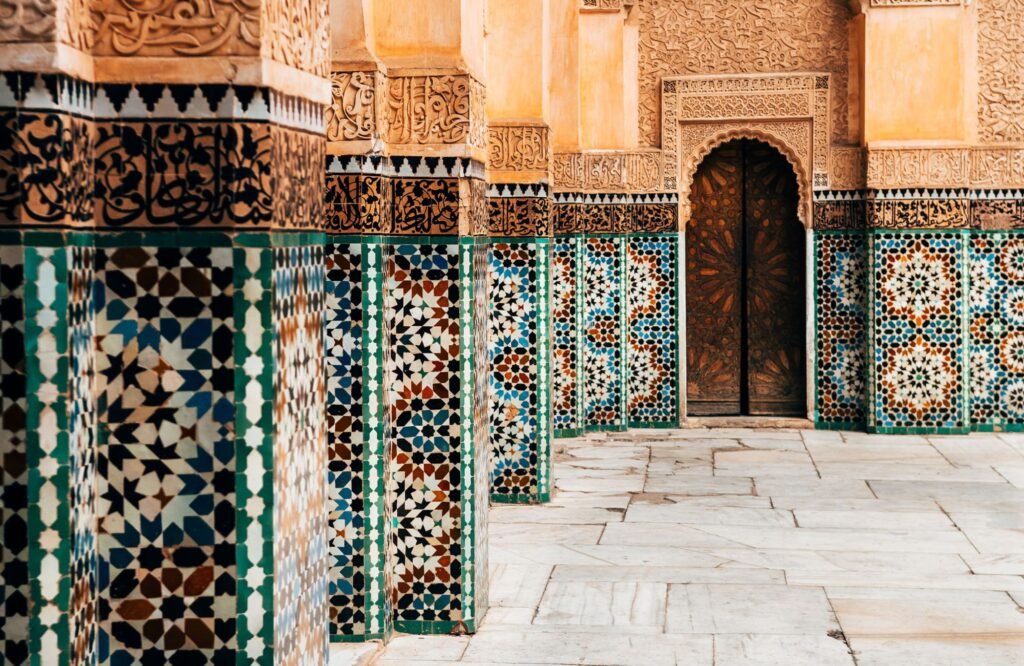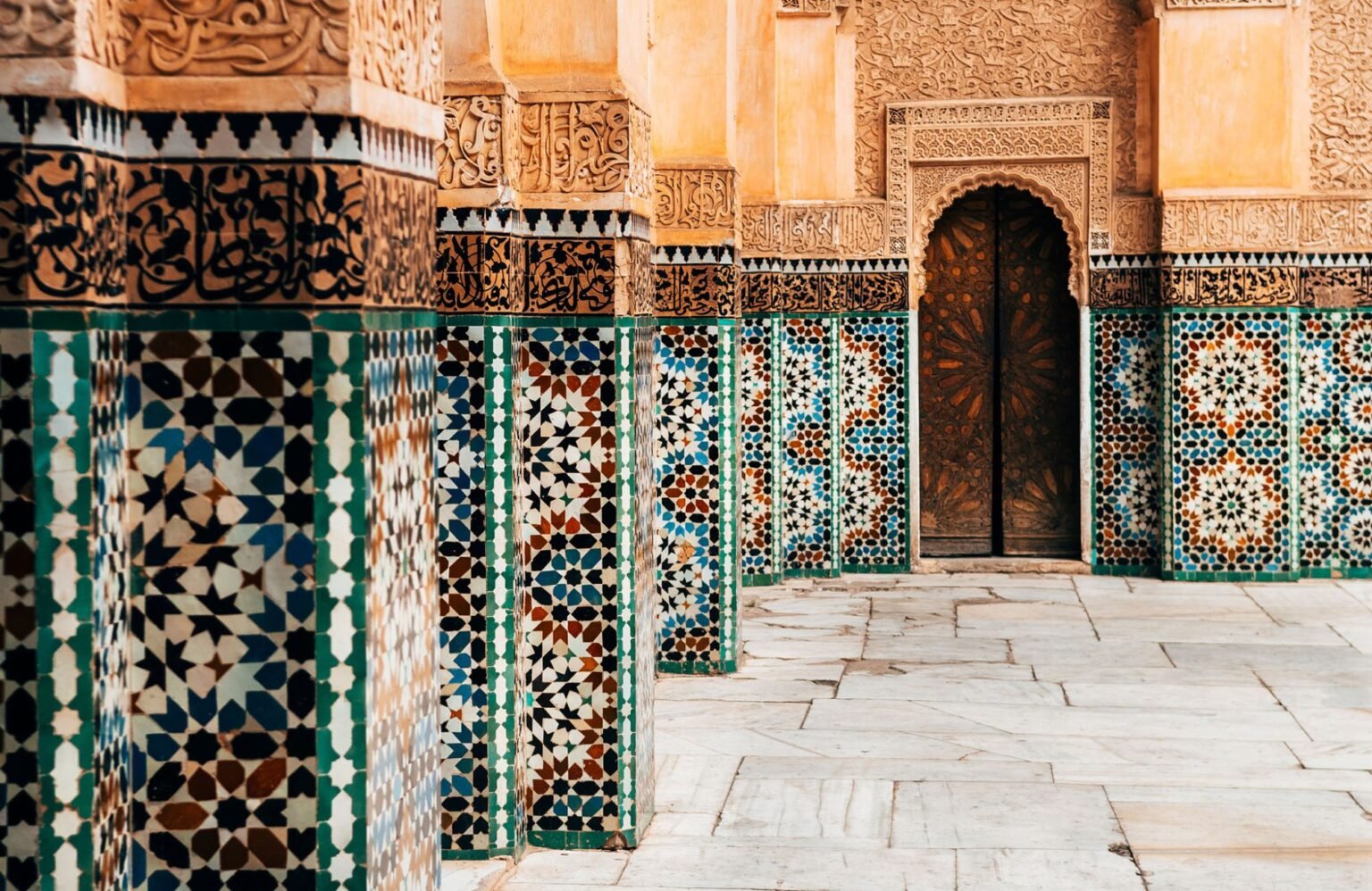
Moroccan homes are a captivating blend of functionality, beauty, and spirituality, reflecting centuries of Islamic architectural influence. These dwellings transcend mere shelter, embodying a cultural narrative woven from the threads of history, religion, and tradition. From the bustling medinas of Fez to the tranquil villages of the Atlas Mountains, the design of Moroccan homes showcases a harmonious marriage of form and purpose. Rooted in Islamic principles, these structures emphasize privacy, community, and a deep connection to the divine. This article explores how Moroccan homes serve as living testaments to Islamic architectural ideals, revealing a legacy that continues to thrive in the modern era.
The Foundations of Islamic Architecture in Morocco
Islamic architecture arrived in Morocco with the Arab conquests of the 7th century, bringing with it a distinct aesthetic and philosophical approach. The religion’s emphasis on modesty, introspection, and communal living profoundly shaped residential design. Moroccan homes often feature inward-facing layouts, with rooms arranged around a central courtyard. This design not only ensures privacy—a core Islamic value—but also fosters family unity. The courtyard, or riad, acts as a private oasis, shielded from the outside world, aligning with the Quranic encouragement of personal sanctity. Early influences from Andalusia and the Maghreb further refined this style, creating a unique Moroccan identity.
The Role of the Courtyard: A Sacred Heart
At the heart of many Moroccan homes lies the courtyard, a space that encapsulates Islamic architectural ingenuity. This open-air area serves as a multifunctional hub for family life, from daily chores to social gatherings. Its design reflects the Islamic principle of balance, offering natural light and ventilation while maintaining seclusion. Tiled floors, intricate stucco work, and lush greenery often adorn these spaces, echoing the paradise gardens described in Islamic texts. The courtyard’s inward focus contrasts with Western outward-facing homes, highlighting a cultural preference for introspection over exposure. This architectural choice remains a defining feature of Moroccan residences, even in urban settings.
Privacy as a Pillar of Design
Privacy is a cornerstone of Islamic life, and Moroccan homes are masterfully designed to uphold this value. High walls, minimal exterior windows, and labyrinthine entrances deter prying eyes, ensuring the sanctity of the household. The dar—a traditional Moroccan house—often includes a bent entrance, a subtle yet effective barrier that prevents direct views into the interior. This layout aligns with the Islamic concept of hijab, or veiling, extending beyond personal attire to the built environment. Such features not only protect inhabitants but also create a sense of mystery, drawing visitors into a world where intimacy and hospitality coexist seamlessly.
Geometric Patterns: A Language of the Divine
One cannot discuss Moroccan homes without marveling at their geometric patterns, a hallmark of Islamic art. These intricate designs, found in tiles, plasterwork, and wood carvings, reflect a belief in the infinite nature of God. Straight lines and repeating shapes symbolize order and unity, avoiding human or animal depictions in line with traditional Islamic aniconism. The zellige tilework, with its kaleidoscopic mosaics, adorns walls and floors, transforming utilitarian spaces into works of art. This aesthetic, honed over centuries, draws from mathematical precision and spiritual symbolism, offering residents a constant reminder of the divine presence within their homes.
Arches and Domes: Echoes of Grandeur
Arches and domes, iconic elements of Islamic architecture, find subtle expression in Moroccan homes. The horseshoe arch, borrowed from Andalusian traditions, graces doorways and passages, blending elegance with structural integrity. Though grand domes are more common in mosques, smaller domed ceilings occasionally appear in wealthier residences, symbolizing the vault of heaven. These features not only enhance aesthetics but also serve practical purposes, such as distributing weight and improving acoustics. Their presence in homes underscores a cultural reverence for sacred spaces, blurring the lines between the domestic and the divine in a way that feels distinctly Moroccan.
Materials and Craftsmanship: A Legacy of Skill
The materials used in Moroccan homes—adobe, wood, and clay—reflect both the local environment and Islamic architectural traditions. Artisans employ time-honored techniques, such as hand-carved cedarwood and tadelakt plaster, to create durable yet beautiful interiors. The use of natural materials aligns with Islamic teachings of stewardship over the earth, while the labor-intensive craftsmanship honors the human spirit. In cities like Marrakech, homes showcase vibrant colors derived from mineral pigments, a nod to the region’s rich resources. This fusion of practicality and artistry ensures that each dwelling is a unique expression of its inhabitants’ values and heritage.
The Role of Water: Symbolism and Serenity
Water holds a special place in Islamic culture, symbolizing purity and life, and Moroccan homes often incorporate it thoughtfully. Fountains or small basins in courtyards evoke the gardens of paradise promised in the Quran, offering both spiritual resonance and a cooling effect in Morocco’s arid climate. The gentle sound of trickling water enhances the tranquility of these spaces, inviting contemplation. While not every home can afford such features, even modest residences may include a simple trough or decorative tilework depicting water motifs. This reverence for water ties Moroccan design to broader Islamic traditions, where it serves as both a practical and metaphysical element.
Light and Shadow: A Dance of Ambiance
Islamic architecture masterfully manipulates light, and Moroccan homes are no exception. Small, strategically placed windows—often covered with wrought-iron grilles or stained glass—filter sunlight into mesmerizing patterns. This interplay of light and shadow creates a serene atmosphere, reflecting the Islamic appreciation for beauty as a divine gift. In wealthier homes, mashrabiya screens allow residents to observe the outside world discreetly while diffusing harsh rays. The result is a dynamic interior that shifts with the day, offering a sensory experience that feels both intimate and transcendent. This technique underscores the thoughtful integration of environment and spirituality in Moroccan design.
Communal Spaces: Bridging Family and Faith
While privacy is paramount, Moroccan homes also prioritize communal living, a reflection of Islam’s emphasis on community. Larger residences may include a salon—a reception room where guests are entertained—designed with plush seating and ornate decor. This space bridges the private family sphere with the outside world, embodying the Islamic value of hospitality. The layout encourages interaction, with rooms often opening onto the courtyard for easy access. In rural areas, homes may extend this principle further, incorporating shared ovens or courtyards for village use. This balance of seclusion and sociability showcases how Islamic ideals adapt to Morocco’s diverse social fabric.
Adaptation to Climate: Practical Divinity
Morocco’s varied climate—from scorching deserts to chilly mountains—shapes its homes as much as religion does. Thick adobe walls insulate against heat, while flat roofs in drier regions collect scarce rainwater. These practical adaptations align with Islamic principles of living in harmony with nature. Courtyards provide shade and airflow, reducing reliance on modern cooling systems. Such designs demonstrate a pragmatic approach to faith, where spiritual values enhance survival rather than hinder it. This synergy of climate and culture ensures that Moroccan homes remain functional sanctuaries, preserving their Islamic roots while meeting contemporary needs.
Modern Influences: Tradition Meets Innovation
As Morocco modernizes, its homes evolve, yet Islamic influences persist. Urban apartments may lack courtyards, but developers often incorporate tiled accents or arched doorways as nods to tradition. Wealthy homeowners commission riads restored with modern amenities, blending heritage with luxury. This adaptability mirrors the resilience of Islamic architecture, which has historically absorbed local styles without losing its essence. Organizations like UNESCO, which recognizes Morocco’s medinas, highlight the global value of this legacy. While concrete and steel rise in cities, the spirit of the dar and riad endures, proving that tradition can thrive alongside progress.
Comparison Table: Traditional vs. Modern Moroccan Homes
| Feature | Traditional Moroccan Home | Modern Moroccan Home |
|---|---|---|
| Layout | Courtyard-centric | Apartment-style |
| Materials | Adobe, wood, clay | Concrete, steel, glass |
| Privacy Features | High walls, bent entrances | Smaller windows, balconies |
| Decorative Elements | Zellige tiles, stucco | Simplified tiles, paint |
| Water Features | Fountains, basins | Rare, decorative only |
FAQs: Exploring Moroccan Homes and Islamic Architecture
What makes a Moroccan home distinctly Islamic?
Moroccan homes reflect Islamic values through privacy-focused designs, geometric patterns, and courtyard layouts that echo paradise gardens, blending faith with daily life.
How do modern Moroccan homes maintain tradition?
Modern homes often incorporate traditional elements like arches or tiles, adapting them to urban constraints while preserving cultural identity.
Why are courtyards so important in Moroccan homes?
Courtyards provide light, air, and a private communal space, embodying Islamic ideals of balance, family, and spiritual serenity.
Are Moroccan homes sustainable?
Yes, their use of local materials and climate-responsive designs, like thick walls and courtyards, aligns with sustainable living principles rooted in Islamic stewardship.
Conclusion: A Living Legacy
Moroccan homes are more than architectural marvels; they are vibrant expressions of Islamic influence, shaped by faith, culture, and environment. From the sacred geometry of zellige tiles to the tranquil ripple of courtyard fountains, these dwellings weave a tapestry of tradition that resonates across centuries. They stand as testaments to a civilization that values privacy, community, and divine beauty, adapting timeless principles to modern realities. As Morocco strides into the future, its homes remain anchors of identity, inviting the world to witness a legacy where every arch and pattern tells a story. For those eager to delve deeper, resources like ArchNet or The Metropolitan Museum of Art offer rich insights into this enduring architectural heritage.

